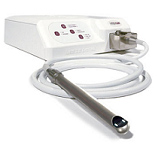|
SERVICES |
||
|
We are pleased to offer the following services and technologies to our patients:
ORAL HYGIENE CARE
Maintaining good oral hygiene is one of the most important things you can do for your teeth and gums. Healthy teeth not only enable you to look and feel good, they make it possible to eat and speak properly. Good oral health is important to your overall well-being. Daily preventive care, including proper brushing and flossing, will help stop problems before they develop. In between regular visits to the dentist, there are simple steps that each of us can take to greatly decrease the risk of developing tooth decay, gum disease and other dental problems. These include:
The following are indications of good oral hygiene:
Back to topDENTAL CLEANING A dental cleaning is a professional cleaning you receive from a dentist or dental hygienist. Most dental cleanings take approximately 45 minutes. Cleanings should be performed every six months to prevent excessive plaque buildup. Plaque left untreated can lead to unhealthy gums and tooth decay. During your routine cleaning we will remove excess plaque and polish your teeth. SEALANTS
 Sealants
are used to fill narrow grooves in a tooth that cannot be
adequately cleaned by brushing. In some cases, the tooth
structure has fine grooves or pits which accumulate plaque, not because
the person doesn't brush, but because they're too narrow to allow even
one bristle into them. To avoid cavities developing over
time, the dentist will brush on a coating that seals the grooves and pits, making it possible to brush off all the plaque and keep your teeth healthy. Back to top Sealants
are used to fill narrow grooves in a tooth that cannot be
adequately cleaned by brushing. In some cases, the tooth
structure has fine grooves or pits which accumulate plaque, not because
the person doesn't brush, but because they're too narrow to allow even
one bristle into them. To avoid cavities developing over
time, the dentist will brush on a coating that seals the grooves and pits, making it possible to brush off all the plaque and keep your teeth healthy. Back to topBONDING First the surface of the tooth is roughened in order to accept the bonding. A gel is applied so the resin will adhere to the surface of the tooth. The composite is then placed on the tooth and the bonding agent hardens with intense light. The last step is shaping and polishing to give a lustrous finish. Back to top FILLINGS There are a variety of filling materials available including gold, silver, plastic and porcelain. The dentist will work with you to determine which material is best, depending on the extent of repair, where in the filling is needed, and cost. Each filling material is briefly explained below:
If decay or a fracture has damaged a large portion of the tooth, a crown (or "cap") may be recommended. Decay that has reached the nerve may be treated through root canal therapy or through a procedure called pulp capping. Back to top
NON-SURGICAL GUM TREATMENT |
|
CROWNS AND BRIDGES
Crowns and
bridges are used to restore and enhance teeth that are damaged or to
take the place of missing teeth. A crown (also referred to as a cap) is
used to entirely cover a damaged tooth. A crown not only
strengthens a tooth, but it can dramatically improve a
tooth’s appearance, shape and alignment.
A
bridge is an ideal method to fill the space created by missing teeth. A
bridge is one or more artificial teeth cemented into place using the
teeth on either side for support. This is an option for filling the
space created by a missing tooth. Bridge work is as much an
art as it is an exact science since it replaces a missing tooth both
functionally and cosmetically. The materials used may be gold alloys,
porcelain bonded to metal alloy, or all ceramic material made to match
your natural tooth color. The choice of material depends on
requirements for strength, wear, and aesthetics. Bridges and crowns are made by first taking an impression of your mouth. The impression is sent to a dental lab where your crown or bridge will be custom made to fit your mouth and match your natural tooth color. A temporary crown or bridge will be placed into your mouth until your permanent crown or bridge is ready and cemented into place. Bridges and crowns are very durable and can last a lifetime with extra care and good oral hygiene. TOOTH EXTRACTIONS
After careful examination and treatment, the dentist may advise to have a tooth extracted. Before a tooth is removed, the dentist will take an x-ray in order to understand the shape and position of the tooth and surrounding bone. Based on the degree of difficulty, we may refer you to a specialized oral surgeon. For a simple extraction, we will first apply a local anesthetic to prevent pain and discomfort. The tooth will be loosened with a tool called an elevator and then removed with dental forceps. Once the procedure is complete, the area may be closed with one or two stitches. We will then provide you with care instructions to alleviate discomfort and ensure proper healing. Back to top WISDOM TOOTH EXTRACTIONS Wisdom teeth are a valuable asset to the mouth when they are healthy and properly positioned. Often, however, problems develop that require their removal. When the jaw isn't large enough to accommodate wisdom teeth, they can become impacted (unable to come in or misaligned). Wisdom teeth may also grow in sideways, emerge only part way through the gum or remain trapped beneath the gum and bone. A wisdom tooth extraction is a relatively routine procedure. The dentist will numb the area in your mouth with a local anesthesia or use IV sedation so you are asleep during the procedure. After the tooth is removed, we will provide care instructions to ensure proper healing. Some pain and swelling may occur but will normally subside after a few days. You should call your dentist if you have prolonged or severe pain, swelling, bleeding or fever. ROOT CANAL TREATMENT Root
canal treatment (also referred to as root canal therapy or endodontic
therapy) is made necessary when an untreated cavity reaches
all the way to this pulp. Treatment may also be
needed when deep restorations or trauma to a tooth cause nerve
damage. Once the pulp becomes infected, it can begin
to eat away at the surrounding bone (this is known as an
abscess). If the pulp is infected, not only is it
painful but it will require treatment as it cannot heal on its
own. Symptoms that indicate
the pulp has become infected may include sensitivity to
hot/cold or sweets, pain, swelling, pain to biting or pressure, and a
bad taste in the mouth. However, sometimes no symptoms are
apparent and you may be unaware of any problem until
a checkup. Root
canal treatment (also referred to as root canal therapy or endodontic
therapy) is made necessary when an untreated cavity reaches
all the way to this pulp. Treatment may also be
needed when deep restorations or trauma to a tooth cause nerve
damage. Once the pulp becomes infected, it can begin
to eat away at the surrounding bone (this is known as an
abscess). If the pulp is infected, not only is it
painful but it will require treatment as it cannot heal on its
own. Symptoms that indicate
the pulp has become infected may include sensitivity to
hot/cold or sweets, pain, swelling, pain to biting or pressure, and a
bad taste in the mouth. However, sometimes no symptoms are
apparent and you may be unaware of any problem until
a checkup. A root canal is performed to clean out the infected tooth pulp and disinfect the canals of the tooth. Alternate treatment would be to extract the tooth. Once the infection is resolved, the canal is filled in to prevent any further infection. Usually a core build-up and crown is recommended for restoring a tooth that has undergone root canal therapy. Back to top
DENTAL IMPLANTS To receive implants, you need to have healthy gums and adequate bone to support the implant. You must also be committed to excellent oral hygiene and regular dental visits as these are critical to the long-term success of dental implants. Back to top
This restoration method is used to restore your smile and mouth function if all your teeth have been lost. The dentures are custom created to resemble natural teeth and are positioned to take the place of natural teeth. Complete dentures are removable and may require adjustments in order to create a proper fit with the gums and mouth. A removable partial denture is a device used when one or more natural teeth still remain in the upper or lower jaw. They usually consist of replacement teeth attached go a gum-colored plastic base which is held in place in the mouth. A fixed partial denture acts the same as a removable denture, but it is cemented into place using adjacent teeth for support. New
dentures may feel awkward or loose for the first few weeks until the
muscles of your cheek and tongue learn to keep them in place and you
are comfortable eating and speaking. Although this may require some
practice you will adjust and enjoy the benefits a full mouth of teeth
can provide.
If
you have decided a guard is right for you, we will take an
impression of your teeth which will then be sent to a lab to make a
custom fit guard. In most cases you can choose from a variety
of colors and styles. On average, guards last between 3 and 10 years. TMJ TREATMENTS Symptoms of TMJ include:
Dental
treatments for the condition can include replacing missing teeth,
moving teeth, adjusting the bite and filling gaps between
teeth. There is no one solution that is right for all
cases. Occasionally a plastic mouthpiece is used to prevent
clenching or grinding that is contributing to the problem. If untreated
and in severe cases, surgery may be required to repair a badly damaged
joint. |
|
Tooth
whitening is a popular procedure to make teeth whiter and brighter, and
therefore more attractive. Bleaching can be used to whiten stained and
discolored teeth, or simply to enhance a dull smile. Either
way, tooth whitening is a safe and relatively painless procedure ideal
for most patients. Our office offers two methods of whitening: in-office whitening and tray whitening.
Tray
whitening is a less expensive whitening treatment you can use while in
the comfort of your own home. We will first take an
impression of your mouth to create customized clear whitening
trays for you to wear. Within a few days your trays will be
ready to be picked up and we will show you how to apply the special
bleaching material to the trays. The whitening gel trays
should be worn 30-60 minutes up to twice a day. At the end of
this period, you will see maximum whitening results that are nothing
short of dazzling. Occasional treatment can be used at your
convenience to maintain your new smile. ORTHODONTICS
Ceramic “Tooth Colored” Brackets -- Ceramic braces are translucent brackets that blend in with your natural tooth color. They are used with patients who are concerned about the appearance of their smile as they are less metallic looking than traditional braces. Ceramic braces are designed to resist staining and discoloration over long periods of time. Clear Braces -- Clear Braces utilize brackets made of monocrystalline sapphire, which make the braces nearly see-through except for the thin arch wire. Next to the Invisalign system (below), clear braces are the closest thing to invisible braces. Metal Braces -- Metal Braces are the most economical and traditionally used braces. Metal braces are also ideal for those with more extensive realignment needed. ORTHODONTIC RETAINERS
VENEERS
LUMINEERS can only be made from patented Cerinate porcelain unavailable anywhere other than the Cerinate Smile Design Studio. In just 2-3 visits to your LUMINEERS dentist, you can have a custom-made smile that is clinically proven to last over 20 years - and it is completely reversible since your natural tooth structure is still intact! Get your perfect smile today! |
|
In
order to provide nothing but the best to our patients, our office uses
state-of-the-art technologies in all our procedures. These
new technologies allow us to treat dental cases with extreme precision,
detect dental concerns at early stages, and provide stunning and
customized restorations. When you visit our office you can be confident
that you are receiving on the finest and most advanced in dental
care. We proudly offer and use the following advanced equipment:
X-rays
are a focused beam of x-ray particles passed through bone which produce
an image on special film, showing the structure through which it
passed. This provides the familiar black and white images
doctors and dentists use to dia gnose
problems and disease. Without an x-ray of the whole tooth and
supporting bone and gum tissues, there would be no way to detect
infection or pathology that requires attention. gnose
problems and disease. Without an x-ray of the whole tooth and
supporting bone and gum tissues, there would be no way to detect
infection or pathology that requires attention.
In our office we use digital radiography which allows us to take x-rays using up to 90% less radiation than conventional film x-rays. Using this technology, we are able to take an x-ray of your mouth by using a small sensor which records the image of your teeth and sends it to a computer. The result is a highly detailed image of your mouth that can easily be enhanced to better diagnose dental concerns and determine the very best treatment for each case. Back to top LASER DENTISTRY SOFT TISSUE LASER
DIGITAL IMAGING SOFTWARE
ELECTRONIC CLAIM PROCESSING
|
|
|
 Brush thoroughly twice a day and floss daily
Brush thoroughly twice a day and floss daily
 Crowns may be used to:
Crowns may be used to: oral
health and appearance. Although dentists will use every
measure to prevent tooth loss, there are still sometimes necessary
occasions when a tooth may need to be extracted. A tooth may
need to be extracted for the following reasons:
oral
health and appearance. Although dentists will use every
measure to prevent tooth loss, there are still sometimes necessary
occasions when a tooth may need to be extracted. A tooth may
need to be extracted for the following reasons: 


 Damon Bracket --
Damon Bracket -- 


